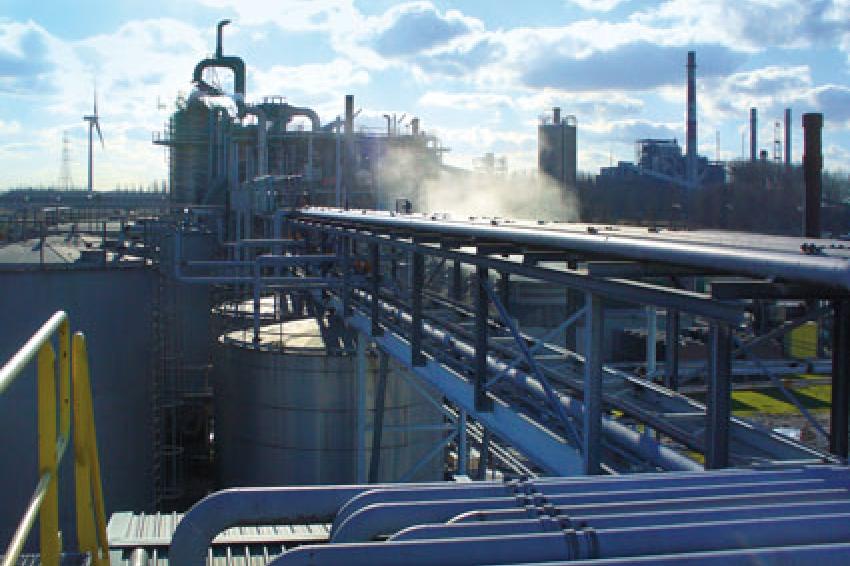Dynea’s Example of Automation on a Small Scale
Increasing Efficiency In Continuous and Batch Manufacturing
New Solutions - As a manufacturer of particle board resins, Dynea Benelux participates in a competitive commodity market and thus establishing a cost-leadership position is crucial. In 2004, although its cost structure was competitive, the business was experiencing more demanding requirements on customer service and flexibility, product quality and business planning and controlling and reporting. In order to meet these requirements, management elected to implement state-of the-art automation solutions.
Goals And Objectives
At the start of the effort, production processes were semi-automated, with the operator controlling the batch from the DCS but still required to complete some activities manually. Administrative systems were stand-alone. The objective of the program was to simplify and increase the level of automation of all business processes, including manufacturing, administration and business planning, control and reporting. By doing so, safety and product quality consistency would be improved, raw material consumption reduced and data capturing, handling and reporting would be faster and more accurate.
It was determined initially to select open, standard software packages from leading suppliers that were designed to meet the specific demands of a small and not too complex process industry site employing both batch and continuous processes. Systems would be configured with a strong focus on process and cost efficiency according to the ISA S88 industry standard. Furthermore, standard tools and set-ups from other Dynea sites and suppliers would be adopted where possible and interfaces between systems would be included in order to eliminate double input and work.
Project Initiation
The project was initiated from the bottom to the top, keeping later phases and the totality of the systems in mind from the start. Increasing process efficiency and automation was followed by increasing the level of automation and integration of manufacturing support systems and ultimately business systems.
To get the most value out of the project, the processes themselves were evaluated to identify opportunities for improvement of efficiency and productivity to make the operations leaner as well as automated. The Emerson DeltaV system was chosen because its offers an integrated solution that follows the ISA-88 Batch standard. It is a DCS with multi-unit recipe control and integrated batch automation. In addition, all of its components are designed to use a single configuration database, and the DeltaV Batch History module is included. Furthermore, using the standard modules and tools available from the Emerson Project Builder Library, design and implementation time were significantly reduced.
Implementation
At the time of project implementation, the existing system was not designed for recipe handling and batch automation, was not easy to configure and it was getting difficult to obtain good support and spare parts. Paper documentation for batch and production data, material consumption, formulations, quality control, production scheduling and other activities was required, and only basic process controls were automated using a PLC-based system.
The first step, therefore, was to increase automation of processes including better automated equipment (e.g. valves) and monitoring systems (flow, weight, etc.). Most importantly, controls were installed for automated batch sequence. The DeltaV software also includes the ability to control specific actions at various levels, build recipes and manage campaigns, and provides one operator interface, making it easy to monitor the system. Batch-based analysis tools have helped dramatically with early identification and resolution of operational problems. Web-based access enables easy interaction with the program and provides flexibility in scheduling batches. Dynea's intranet is protected with a firewall and a gateway to the Internet. Integration at the top level did not take place until Dynea adopted a corporate-wide ERP system in 2008.
Until this time, different sites, which historically came from different companies (Neste Chemicals, Dyno), utilized different systems. With adoption of the company-wide ERP system, data from the DeltaV DCS at Dynea Benelux (raw material consumption, production figures, analytical data and shipment numbers) are exported to the ERP system, and the Benelux business has rapid access to necessary administrative and other corporate level information.
Results
Automating operations has led to improved product quality and reliability. Operations are more efficient due to improved production planning. Business activities (logistics, financial) are also more efficient due to ready access to production, sales, shipping and order information. Reduced resource consumption (raw materials, paper, energy) and waste generation help with cost reduction and environmental compliance. The DeltaV system also provides good plant benchmarking possibilities. The performance of each plant and how individual plants are performing in relation to each other can be evaluated, resulting in improved operational insight.
Challenges
Throughout implementation of the automation system, the biggest challenge was getting the operators to adjust to the changes. Most feared losing their jobs once efficiency was improved. Dynea, however, retrained the operators for expanded responsibilities so that they now do multiple tasks in addition to performing their operator duties. Commitment by management helped overcome this problem.
The openness of the DeltaV software, while a great benefit, also presented a challenge as well. People experienced in programming the DCS system are required to maximize its use. Therefore it was necessary to find production people looking for the opportunity to learn this skill and expand further their responsibilities. Fortunately, some people volunteered and have been trained.
Conclusions
The results at Dynea Benelux demonstrate that it is not necessary to be big to benefit from being lean and automated. When making such significant operational changes, however, it is very important to proceed at the right speed and consider employee concerns. People still have to operate the automated systems and must accept the changes, or the investment will not bring the proper return.
Finally, the introduction of automated systems has been successful and we are thus considering other opportunities including more automated production scheduling, integration of the DeltaV and Oracle ERP systems for plant maintenance operations and more integration on the Dynea Europe level for activities such as supply chain planning.
Contact
Dynea Oy
Siltasaarenkatu 18-20a
00530 Helsinki
Finland
+358 10 5852031






